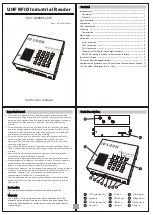
4-8
39014-03 06/16
VERSALIFT VST-36/40/47/52-I
OPERA
TION
to control all lift movements.
Lift operations are selected by depressing the safety
trigger while actuating the single stick control handle.
Slowly move the single stick lever in the desired
direction until motion begins. Further movement of
the handle in the same direction will increase the
speed of the motion. To stop a lift movement, move
the single-stick lever back to the neutral position and
release the trigger. Releasing the safety trigger in
any position except neutral will cause the selector
valve to slam shut and stop lift travel with an abrupt
jerking motion resulting in unnecessary loads and
stresses.
To operate two or more functions at the same time,
position the single-stick handle anywhere in an area
between the separate paths of the desired functions.
EMERGENCY STOP (Standard)
- The primary
purpose of the emergency stop valve is to deactivate
all the upper controls in the event of a control valve
malfunction (i.e. a valve spool stuck in the open
position) or other hydraulic emergency. Push the
knob labeled “PUSH FOR EMGY. STOP”; then the
upper controls are inoperable and pressure at the
tool ports is relieved. When the emergency stop knob
is pulled up, the upper controls and tool power are
functional.
ENGINE START/STOP (Standard)
- The start/stop
system has been designed so that the engine cannot
be started unless the ignition switch is in the “RUN”
position and the master control switch is activated.
This feature makes it difficult for unauthorized
individuals to operate the lift when the truck is locked.
The engine start/stop system is operated by an air
cylinder at the upper controls.
DANGER
:
THE TRUCK TRANSMISSION
MUST BE IN NEUTRAL BEFORE USING THE
ENGINE START/STOP. STARTING THE TRUCK IN
GEAR WILL CAUSE MOVEMENT WHICH MAY
CAUSE DEATH OR SERIOUS INJURY TO THE
OPERATOR IN THE LIFT OR ANYONE IN THE PATH
OF THE TRUCK.
To start the truck engine from the upper controls
,
push the air cylinder plunger knob down and hold the
knob until the engine starts. If the truck starter does
not engage, release the plunger knob and allow the
plunger to rise to the neutral position. A second push
on the plunger may be required to get the latching
relay into position so the engine will start.
To stop the truck engine from the upper controls
,
push the air cylinder plunger knob down to get the
latching relay into the stop position.
HYDRAULIC PLATFORM LEVELING (Standard)
-
Platform leveling is achieved with a master and slave
cylinder arrangement. However, the hydraulic platform
control at the platform and turret can be used to adjust
platform leveling, tilt the platform for cleanout, or ease
the removal of an injured operator.
HYDRAULIC TOOL POWER (Standard)
- The
hydraulic tool power ports are mounted outside the
fiberglass guard that surrounds the upper controls.
Always relieve the pressure to the tool ports before
connecting or disconnecting the hydraulic tool hoses.
To relieve the pressure, push the Tool Power Valve
Knob in completely. Connect the hydraulic tool hoses
to the tool ports (quick-disconnect outlets). Activate
operating pressure to the hydraulic tools by pulling
the Tool Power Valve Knob out.
WARNING
:
FAILURE TO RELIEVE
PRESSURE TO THE TOOL PORTS BEFORE
CONNECTING OR DISCONNECTING THE
HYDRAULIC TOOL HOSES MAY RESULT IN A
HIGH PRESSURE HYDRAULIC OIL SPRAY. THIS
SPRAY OR MIST CAN PUNCTURE AND BECOME
EMBEDDED BENEATH THE SKIN OR
CONTAMINATE THE EYES. THESE CONDITIONS
REQUIRE IMMEDIATE MEDICAL ATTENTION.
HYDRAULIC PLATFORM ROTATION (Standard)
-
The platform mount allows the platform to rotate 180°.
To rotate, place the handle in the clockwise or counter-
clockwise (“CW” or “CCW”) position.
TWO-SPEED MANUAL THROTTLE CONTROL
(Option)
- The two-speed manual throttle control is
operated by an air cylinder plunger knob at the upper
controls. The two-speed control is designed to operate
only if the engine is running and the master control is
activated.
To speed up the engine from the upper controls,
push the plunger knob down once and release it.
To slow the engine to an idle from the upper
controls,
push the plunger knob down and release
it. It is recommended that the engine be left at idle
until faster lift movements are required. This practice
will provide efficient operation and minimize fuel
consumption. During hydraulic tool operation the oil
flow will be adequate to operate the tools at idle speed.
Summary of Contents for VST-36-I
Page 2: ......
Page 4: ......
Page 6: ......
Page 11: ...2 3 39014 03 06 16 VERSALIFT VST 36 40 47 52 I RESPONSIBILITIES SAFETY ...
Page 12: ...2 4 RESPONSIBILITIES SAFETY 39014 03 06 16 VERSALIFT VST 36 40 47 52 I ...
Page 18: ......
Page 27: ...3 9 39014 03 06 16 VERSALIFT VST 36 40 47 52 I SPECIFICATIONS ...
Page 28: ...3 10 39014 03 06 16 VERSALIFT VST 36 40 47 52 I SPECIFICATIONS ...
Page 29: ...3 11 39014 03 06 16 VERSALIFT VST 36 40 47 52 I SPECIFICATIONS ...
Page 30: ...3 12 39014 03 06 16 VERSALIFT VST 36 40 47 52 I SPECIFICATIONS ...
Page 31: ...3 13 39014 03 06 16 VERSALIFT VST 36 40 47 52 I SPECIFICATIONS ...
Page 36: ...3 18 39014 03 06 16 VERSALIFT VST 36 40 47 52 I SPECIFICATIONS ...
Page 37: ...3 19 39014 03 06 16 VERSALIFT VST 36 40 47 52 I SPECIFICATIONS ...
Page 38: ......
Page 60: ...6 4 39014 03 06 16 VERSALIFT VST 36 40 47 52 I DAILY VISUAL INSPECTION ...
Page 61: ...6 5 39014 03 06 16 VERSALIFT VST 36 40 47 52 I DAILY VISUAL INSPECTION ...
Page 62: ...6 6 39014 03 06 16 VERSALIFT VST 36 40 47 52 I DAILY VISUAL INSPECTION ...















































